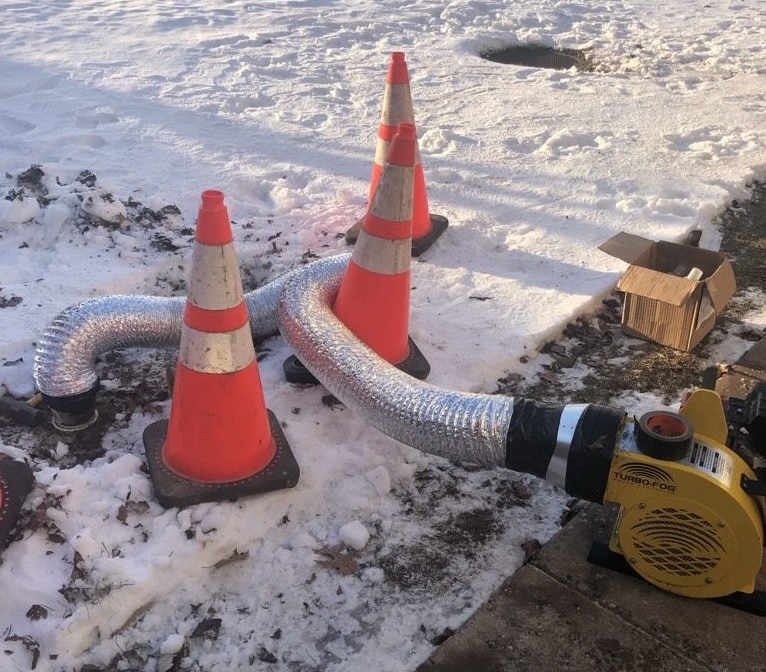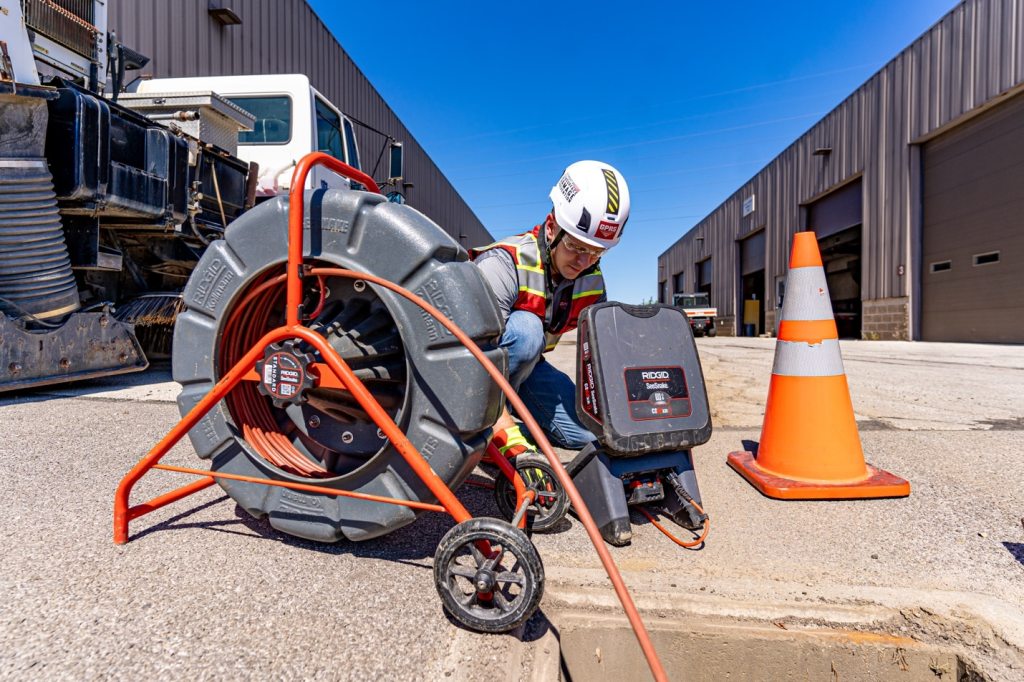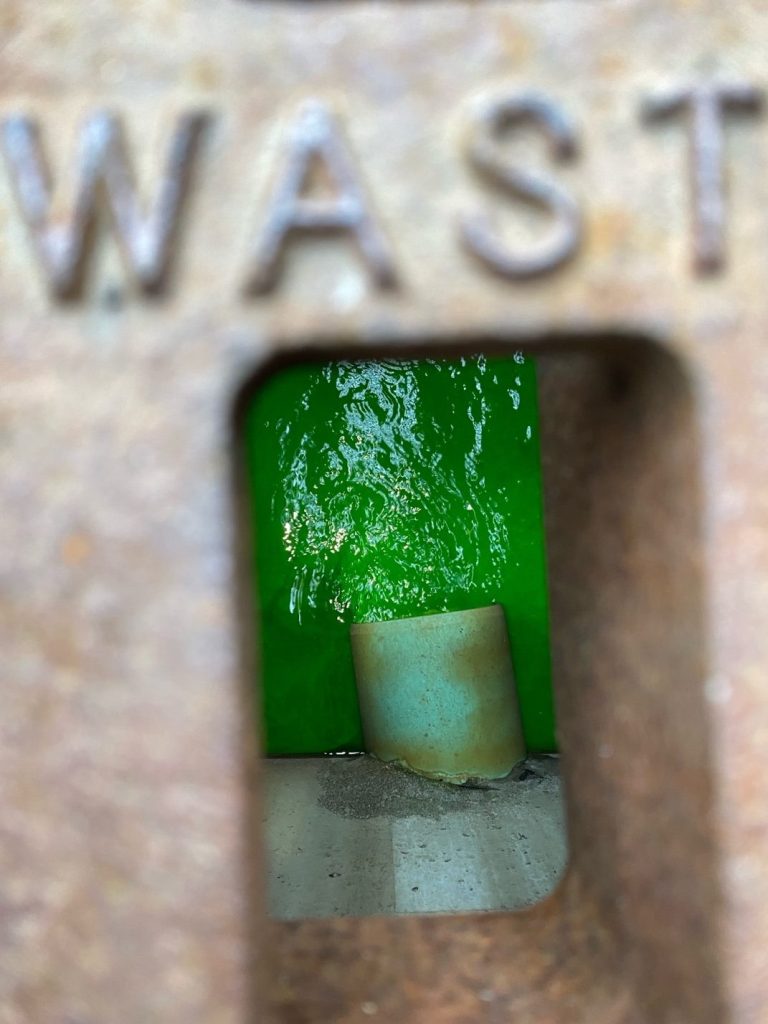What’s that smell?
GPRS’ video pipe inspection services, which utilize remote-controlled robots, push-fed sewer scopes, dye tracing, and smoke testing, recently uncovered an illegal sewer connection that was causing sewage buildup in a strip mall’s wastewater system.
Project Manager Dakota Stoutenger was called to the scene in Chappaqua, New York, by the real estate investment firm that owns the plaza. One of the mall’s tenants had reported a persistent foul odor but couldn’t locate its source.

: Smoke testing is a simple, non-invasive technique for detecting defects and blockages in sanitary and storm sewer lines, identifying potential inflow and infiltration (I/I) points, and exposing illegal (illicit) sewer connections.
Stoutenger began the investigation with smoke testing, inspecting all sanitary vents from the roof down to check for defects.
Smoke testing is a straightforward, non-invasive method to detect issues in sanitary and storm sewer lines, identify potential inflow and infiltration (I/I) points, and expose illegal sewer connections. While it’s effective for detecting the presence of an issue, more detailed investigation is often required to pinpoint the exact cause.
The smoke testing process involves three key steps. First, a smoke cartridge insertion point is identified. Next, a blower with the cartridge is securely attached to the sewer entry, releasing non-toxic smoke into the line. GPRS Project Managers then observe where the smoke escapes.
In a properly maintained system, smoke will escape through manhole covers and plumbing vents of buildings that are legally connected. However, if smoke appears from cracks in the pavement or the ground, it indicates a sewer defect or infiltration risk. Smoke from a cleanout likely signals a cracked cap, and smoke from manhole covers, vents, or gutters not meant to be connected points to an illicit tie-in.

GPRS utilizes push-fed sewer scopes equipped with CCTV cameras and sondes: instrument probes that allow our Project Managers to locate and map buried sewer lines from the surface using electromagnetic (EM) locating.
After completing the smoke test, Stoutenger couldn’t immediately identify the source of the foul odor.
“Because of that, I suggested we conduct additional services to investigate further,” he said.
He then deployed a push-fed sewer scope with a CCTV camera and a sonde—a probe that allows the mapping of sewer lines from the surface using an electromagnetic (EM) locator. Stoutenger also conducted more smoke testing on the sanitary sewer and grease trap systems.

Dye tracing involves introducing a non-toxic, brightly colored dye into a sewer system to track and identify flow patterns, locate blockages, detect leaks, and ensure proper connectivity.
Finally, he performed dye tracing on the plaza’s stormwater system
Dye tracing, or dye testing, involves introducing a non-toxic, brightly colored dye into a sewer system to trace flow patterns, locate blockages, detect leaks, and confirm proper connectivity. The dye travels with the wastewater flow, helping GPRS Project Managers observe the movement of the water-soluble chemical to assess the system’s condition and behavior.
Sometimes, UV lights or flashlights are used to improve visibility, and photographic evidence is gathered to document the dye’s movement and any detected issues.
Through this comprehensive inspection process, Stoutenger finally discovered the likely cause of the smell.
“I found that the neighboring tenant’s sanitary system was tied to the grease trap intended for a potential restaurant tenant,” he explained. “This improper connection led to the accumulation of sewage in the grease trap manhole/vault right outside the back door of the tenant who was reporting the odor. With this information, the client could properly reconnect the system to the correct sanitation point.”
Stoutenger provided the client with a NASSCO-certified report, complete with photo and video evidence of his findings.
NASSCO, the National Association of Sewer Service Companies, offers leading training on non-destructive techniques for detecting and reporting sewer line anomalies. All GPRS VPI Project Managers are certified in NASSCO’s Pipeline, Lateral, and Manhole Assessment Certification Programs (PACP®, LACP®, and MACP®), ensuring that they deliver top-tier service to maintain the integrity of your wastewater infrastructure.
All the field-verified, accurate data Stoutenger collected for our client was uploaded into SiteMap® (patent pending), our facility and project management application that provides accurate existing conditions documentation to protect assets and people.
Securely, yet easily accessible via computer, tablet, or smartphone, SiteMap® allows for seamless communication between stakeholders to eliminate the mistakes that come from miscommunications.
GPRS’ SiteMap® team members are currently scheduling live, personal SiteMap® demonstrations. Click below to schedule your demo today!
Frequently Asked Questions
What deliverables does GPRS offer when conducting video pipe inspection services?
GPRS is proud to offer WinCan reporting to our Video Pipe Inspection clients. Maintaining sewers starts with understanding sewer condition, and WinCan allows GPRS Project Managers to collect detailed, NASSCO-compliant inspection data. GPRS Project Managers not only inspect the interior condition of sewer pipes, laterals, and manholes – they can also provide a map of their location. The GPRS Mapping & Modeling Department can provide detailed GPS overlays and CAD files. Our detailed WinCan/NASSCO reports contain screenshots of the interior condition of the pipe segments that we inspect, as well as a video file for further evaluation, documentation, and/or reference.
Can you locate pipes in addition to evaluating their integrity?
Yes! Our SIM- and NASSCO-certified Project Managers use VPI technology equipped with sondes, which are instrument probes that allow them to ascertain the location of underground utilities from an inaccessible location. This allows them to use electromagnetic (EM) locating to map sewer systems at the same time they’re evaluating them for defects.
Does GPRS offer lateral launch services?
Yes, we offer lateral launch capabilities as part of our standard Video Pipe Inspection services.
